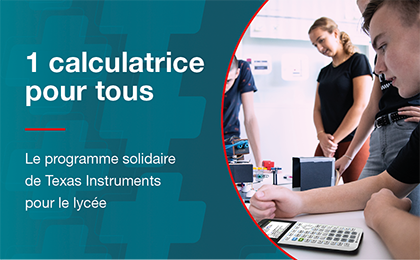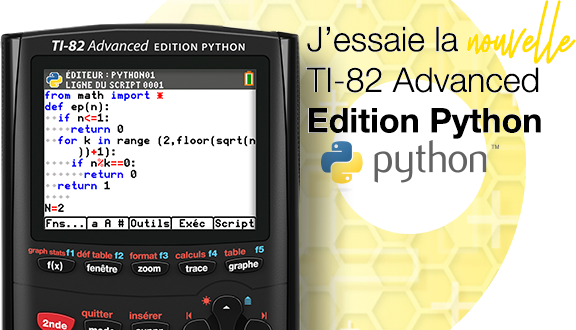Choisir sa calculatrice :
Tableau de comparaison (QCC 2024)
Analyse/Guide complet (QCC 2024)
Tutos mode examen :
Candidats : Activation • Liste modèles conformes
Surveillants : Lancement épreuves • Revalidation
Welcome to TI-Planet, the reference scientific and graphing calculators community !
-
Facebook Instagram X/Twitter YouTube Discord
Social TI-Planet
-
Donations / Premium
For more contests, prizes, reviews, helping us pay the server and domains...
Donate
Discover the the advantages of a donor account !
JoinRejoignez the donors and/or premium!les donateurs et/ou premium !
Donate
Discover the the advantages of a donor account !
JoinRejoignez the donors and/or premium!les donateurs et/ou premium !
-
Stats.
2154 utilisateurs:
>2130 invités
>17 membres
>7 robots
>2130 invités
>17 membres
>7 robots
Record simultané (sur 6 mois):
29271 utilisateurs (le 11/07/2025)
29271 utilisateurs (le 11/07/2025)
News
- Catégories
- TI-Nspire
- TI-82 / 83 / 84
- TI-89 / 92 / Voyage 200
- TI Scientifiques
- Casio
- NumWorks
- HP (Moravia)
- Sharp (Moravia)
- Symbolibre, Librecalc
- Lexibook, Truly
- Zero
- Examens - Concours
- Divers
- All news
- Latest news
- Bêta-test public mise à jour Epsilon 24.2 pour NumWorks491
[NumWorks] (15/07 09:39) - Coque NumWorks édition limitée Juillet 2025 à gagner869
[NumWorks] (03/07 10:06) - Nouveau site Jarrety rénové pour la rentrée 20251265
[Divers] (30/06 16:19) - Sortie logiciel connectivité ZeroConnect 2.5.1 Windows/Mac1194
[Zero] (30/06 14:57) - À la carte NumWorks concours Python 2024-20251757
[NumWorks] (29/06 16:00) - Test différentiel fx-CP400+E révisée avec nouvel écran1857
[Casio] (24/06 16:14) - Emus en ligne sans compte fx-92 Collège & Graph Light/Math+1045
[Casio] (23/06 10:23) - Sortie émulateur en ligne Zero ZGC4 !3784
[Zero] (17/06 13:16) - Précommande calculatrice Zero ZGC4 à 90$ (au lieu de 115$)2718
[Zero] (17/06 08:00) - Epreuve Maths anticipée Première 2025-2026 sans calculatrice11788
[Examens/Concours] (12/06 14:01)
Programs &
Downloads
- Downloads
- TI-Nspire
- TI-83 Premium CE / 84+CE / 82APy
- TI-82 Advanced / 84+T
- TI-82+ / 83+ / 84+
- TI-76.fr / 82 Stats / 83
- TI-89 / 92 / Voyage 200
- NumWorks
- Casio Graph 25 35 75 85 95
fx-7400/9750/9860 G/GII/GIII - Graph Math+/90+E - fx-CG10/20/50
- Casio fx-CP400/CG500
- HP Prime
- 39gII
- 49/50
- 48
- Selections (Exams, tools, lessons...)
- Upload a file
- My uploaded files
- Latest files
-
Manager Subscription fx-CG50 / Graph 90+E 3.80.1b
0
[Utilitaires Mac Casio Graph Math+/90+E/fx-CG] (Casio) -
Graph Reset
1
[Utilitaires TI-83 Premium CE / 84+CE / 82APy] (Artcas2) -
Solitaire - Les huit ennemis
2
[Jeux NumWorks] (Florian Allard) -
Solitaire (billes)
3
[Jeux NumWorks] (Florian Allard) -
Problème des 8 dames
4
[Jeux NumWorks] (Florian Allard) - Latest updates
-
Awale
1
[Jeux NumWorks] (Florian Allard) -
First Fantasy: Mana Force v6.0.4
1774
[Jeux TI-83 Premium CE / 84+CE / 82APy] (DJ Omnimaga) -
PythonExtra
175
[Utilitaires Casio Graph Math+/90+E/fx-CG] (Sébastien Michelland) -
RadioactiveWastes
278
[Jeux HP-Prime] (Piotr Kowalewski)
- Popular files
-
DNB 2025 - SVT (Asie)
2169
[Tutoriaux Brevet Autres...] () -
Flappy bird color
184
[Jeux Casio Graph Math+/90+E/fx-CG] (Lancelot) -
CGDoom fx-CG50 / Graph 90+E
177
[Jeux Casio Graph Math+/90+E/fx-CG] (Lephenixnoir) -
Oiram CE (mario-like)
173
[Jeux TI-83 Premium CE / 84+CE / 82APy] (MateoConLechuga) -
TI Connect CE (v5.4.0, Windows)
168
[Utilitaires PC TI-83 Premium CE / 84+CE / 82APy] (Texas Instruments) -
nPDF 0.4 beta
161
[Utilitaires TI-Nspire] (Legimet) -
Doom (Shareware)
148
[Jeux Doom Casio Graph Math+/90+E/fx-CG] (Id Software) -
Geometry Dash CE
132
[Jeux TI-83 Premium CE / 84+CE / 82APy] (Epharius) -
PacMan CE
118
[Jeux TI-83 Premium CE / 84+CE / 82APy] (MateoConLechuga) -
Ndless r2019 (OS 5.3, 5.2, 4.5.4, 4.5.3, 4.4, 4.2, 4.0, 3.9, 3.6)
99
[Utilitaires Kernels TI-Nspire] (Ndless team)
Converters
- Latest converted documents
- Archivo 8.1
[nCreator TI-Nspire] (urban97g@gmail.com) - Archivo 8
[nCreator TI-Nspire] (urban97g@gmail.com) - Archivo 5.1
[nCreator TI-Nspire] (urban97g@gmail.com) - Archivo 7
[nCreator TI-Nspire] (urban97g@gmail.com) - Archivo 6
[nCreator TI-Nspire] (urban97g@gmail.com) - Archivo 6
[nCreator TI-Nspire] (urban97g@gmail.com) - lineas
[nCreator TI-Nspire] (maik404) - papeo
[nCreator TI-Nspire] (ff95) - Archivo 5
[nCreator TI-Nspire] (urban97g@gmail.com) - Archivo 5
[nCreator TI-Nspire] (urban97g@gmail.com)
Forum
- Catégories
- TI-Nspire
- TI-82 / 83 / 84
- TI-89 / 92 / Voyage 200
- TI Scientifiques
- Casio
- NumWorks
- HP
- Divers
- Quick links
- All forums
- Topics of the last 7 days
- Unanswered messages
- Unread messages
- Messages since last visit
- Latest posts
- Re: Il est ou le chat240
Adriweb (17/07/2025 17:36) - Re: Remerciements envoi livre TI-92 top des jeux par Pascalb3936
critor (16/07/2025 15:16) - Re: Bêta-test public mise à jour Epsilon 24.2 pour NumWorks491
parisse (16/07/2025 06:23) - PArtiel65
antoine5901 (15/07/2025 20:06) - Re: Minecraft en 3D!!! Fake?10069
tiGEEK (15/07/2025 12:34) - Re: La TI-83+ complètement déverrouillée !!!3526
Jean38100 (14/07/2025 19:30) - Re: À la carte NumWorks concours Python 2024-20251757
ayabusa (13/07/2025 18:01) - Concours TI-Basic TI 82/83/84 !118
tiGEEK (12/07/2025 13:42) - Re: QCC 2024 : Quelle Calculatrice Choisir ?11031
parisse (11/07/2025 20:48) - Re: PDM - parts de marché calculatrices graphiques France.116232
critor (09/07/2025 09:47)
Gallery
- Latest picture
-
NumWorks Omega + À la carte
[Généralités NumWorks]
© 2011-2025 TI-Planet.
Website managed by UPECS non-profit organization. See our privacy policy.
The proper functioning of TI-Planet relies on cookies. You can configure (and consent to) the usage of optional cookies.
SmartNav : Off (ON = connexion nécessaireON = login required)
Nous ne pouvons pas forcément surveiller l'intégralité du contenu publié par nos membres - n'hésitez pas à nous contacter si besoinWe may not be able to review all the content published by our members - do not hesitate to contact us if needed (info[at]tiplanet[.]org).
Forum powered by phpBB © phpBB Group — Traduction phpBB par phpBB-fr — Some icons from FatCow
The proper functioning of TI-Planet relies on cookies. You can configure (and consent to) the usage of optional cookies.
SmartNav : Off (ON = connexion nécessaireON = login required)
Nous ne pouvons pas forcément surveiller l'intégralité du contenu publié par nos membres - n'hésitez pas à nous contacter si besoinWe may not be able to review all the content published by our members - do not hesitate to contact us if needed (info[at]tiplanet[.]org).
Forum powered by phpBB © phpBB Group — Traduction phpBB par phpBB-fr — Some icons from FatCow












